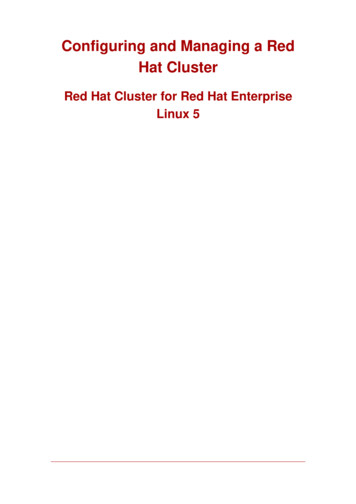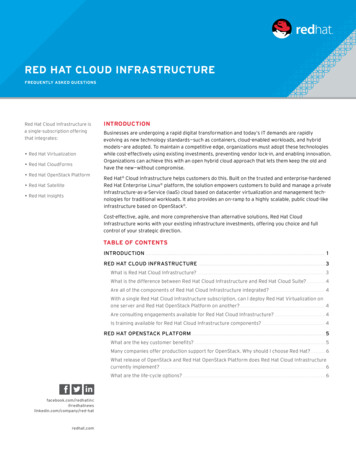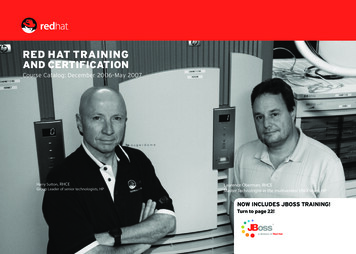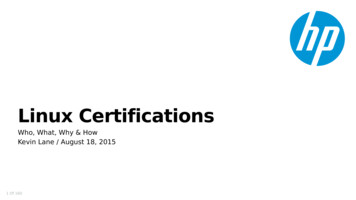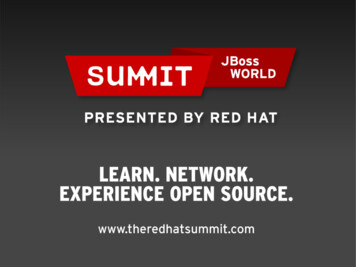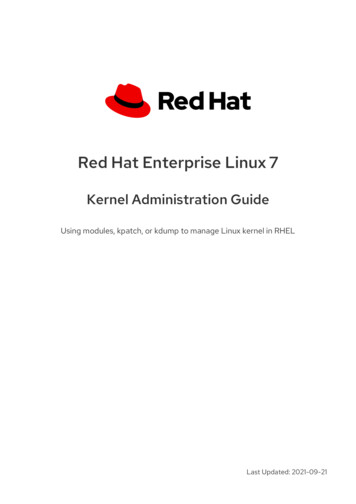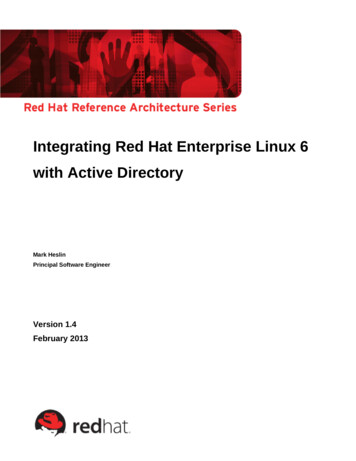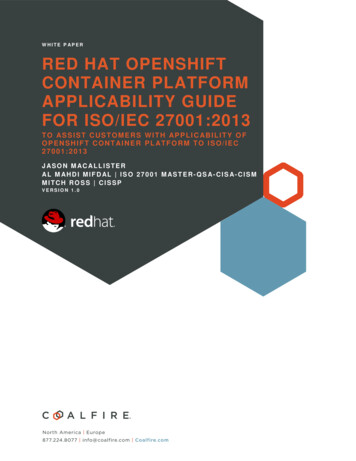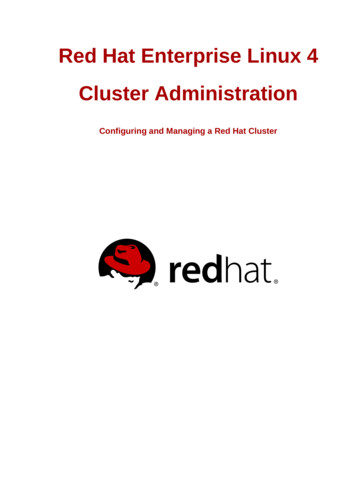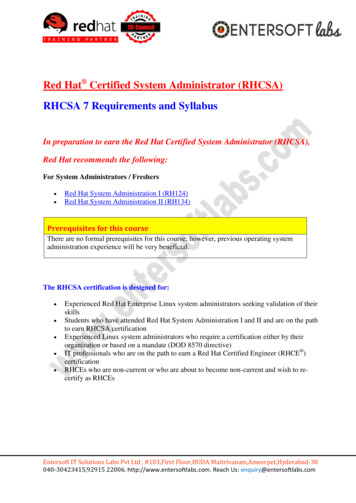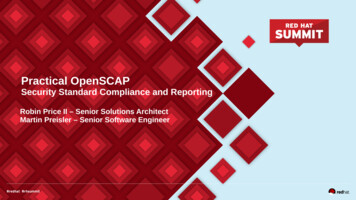
Transcription
Practical OpenSCAPSecurity Standard Compliance and ReportingRobin Price II – Senior Solutions ArchitectMartin Preisler – Senior Software Engineer
INTRODUCTION
AGENDAReview some slides Follow along demostration Deconstruction of each lab step Leave feeling informed and enabled
WHY ARE WE HERE?
WHY ARE WE HERE?Computer security has become increasingly important Two major approaches can be recognized in computer security:– Reactive– Proactive The reactive approach is involved in disaster recover plans– Eliminating the threat– Switching to alternate systems– Attack surface analysis– Investigation– Remediation of compromised systems The proactive approach consists of any actions that reduce the risk of damage orcompromise.
WHY ARE WE HERE? To be able to mitigate consequences of possible attack, the assets at risk must berecognized prior to the attack.To properly implement security guidance, target computers need to be hardenedand continuously monitored during their lifecycle.The major focus of this work is to accommodate compliance audit in largeinfrastructure deployments using open source software.The objective is to enable users to perform the security audit on multiple remotesystems from a single, centralized environments.
WHAT IS SCAP?
WHAT IS SCAP? Security Content Automation Protocol (SCAP) is a collection of standards managedby National Institute of Standards and Technology (NIST). It was created to providea standardized approach to maintaining the security of enterprise systems, such asautomatically verifying the presence of patches, checking system securityconfiguration settings, and examining systems for signs of compromise.The key step in the implementation of SCAP within the organization is having thesecurity policy in the form of SCAP.It is a collection of data formats.
WHAT IS SCAP? For each of the SCAP components mentioned, the standard defines a documentformat with syntax and semantics of the internal data structures.All the component standards are based on Extensible Markup Language (XML) andeach component standard defines its own XML namespace.Any tool which is certified against SCAP 1.2 is required to understand all of theprevious versions of the component standards.
SCAP COMPONENTS SCAP encompassed several underlying standards. The component standards of SCAP include:–Languages: OVAL : A language for making logical assertions about the state of an endpoint system. XCCDF: A language to express, organize, and manage security guidance that references OVAL. OCIL: Open Checklist Interactive Language: a language to provide a standard way of querying a human user. ARF: Asset Reporting Format: a language to express the transport format of information about assets, and therelationships between assets and reports.–Enumerations: CCETM: Common Configuration Enumeration: an enumeration of security-relevant configuration elements forapplications and operating systems CPETM: Common Platform Enumeration: a structured naming scheme used to identify information technologysystems, platforms, and packages. CVE : Common Vulnerabilities and Exposures: an enumeration of security-relevant configuration elements forapplications and operating systems.
SCAP COMPONENTS SCAP encompassed several underlying standards. The component standards of SCAP include (cont.):–Metrics: CVSS: Common Vulnerability Scoring System: metrics to assign a score to software vulnerabilities to help usersprioritize risk. CCSS: Common Configuration Scoring System: metrics to assign a score to security-relevant configurationelements to help users prioritize responses.
WHAT IS OPENSCAP?
WHAT IS OPENSCAP? A framework of libraries and tools to improve the accessibility of SCAP and enhancethe usability of the information it represents.OpenSCAP components:– Library - OpenSCAP library provides API to SCAP document processing andevaluation.– Toolkit– SCAP scanner (oscap) is a command line tool that provides various SCAPcapabilities; for instance: configuration scanner, vulnerability scanner, SCAP contentvalidation and transformation etc. On 04/29/2014 OpenSCAP project received SCAP 1.2 certification from NIST.– http://nvd.nist.gov/scapproducts.cfm
WHAT IS OPENSCAP? The OpenSCAP Tool (oscap) was developed after the OpenSCAP library was matureenough to perform the scan and was the only missing piece (thanks, Peter Vrabec!).The shared library offers wide selection of SCAP functionality, however only a limitedset of features is needed in day-to-day use of SCAP.The oscap command-line utility is a simple front-end to the OpenSCAP library, itgroups its functionality into sub-commands called modules. “xccdf eval” “generate fix”
WHAT TOOLING IS AVAILABLE FOR SCAP? OpenSCAP: suite of open source tools and libraries for security automation OpenSCAP Scanner: command line tool for configuration and vulnerability measurements SCAP Workbench: a GUI tool for scanning and content tailoring, GUI front-end for OpenSCAP SCAP Security Guide: The project provides pre-built profiles for common configuration requirements,such as DoD STIG, PCI, CJIS, and the Red Hat Certified Cloud Provider standards.OSCAP Anaconda: An add-on for the Anaconda installer that enables administrators to feed securitypolicy into the installation process and ensure that systems are compliant from the very first boot.Red Hat Satellite: Centralized systems life-cycle manager with enterprise vulnerability measurements.Red Hat CloudForms: to manage security through the full life cycle of systems and apps in open hybridcloud environments (want to scan Amazon AMIs?).Red Hat Atomic: The ability to scan Docker container images.
WHAT TOOLING IS AVAILABLE FOR SCAP? OpenSCAP: suite of open source tools and libraries for security automation OpenSCAP Scanner: command line tool for configuration and vulnerability measurements SCAP Workbench: a GUI tool for scanning and content tailoring, GUI front-end for OpenSCAP SCAP Security Guide: The project provides pre-built profiles for common configuration requirements,such as DoD STIG, PCI, CJIS, and the Red Hat Certified Cloud Provider standards.OSCAP Anaconda: An add-on for the Anaconda installer that enables administrators to feed securitypolicy into the installation process and ensure that systems are compliant from the very first boot.Red Hat Satellite: Centralized systems life-cycle manager with enterprise vulnerability measurements.Red Hat CloudForms: to manage security through the full life cycle of systems and apps in open hybridcloud environments (want to scan Amazon AMIs?).Red Hat Atomic: The ability to scan Docker container images.
LAB: Part 1
Language Standards(data formats)
Check Language - OVAL
WHAT IS OVAL? OVAL - The Open Vulnerability Assessment LanguageOVAL is an open specification to represent the technical aspects of evauluating compliance witha security guidance line item such as the installation of a specific patch.The main goal of the OVAL standard is to enable interchangeability among security products.OVAL checks are intended to be used by automated assessment tools to evaluate a system'scompliance without requiring user input or intervention.OVAL can be used to assess a system's compilance with a configuration settings, perform aninventory of software that is install on a system, identify missing patches on a system, anddetermine when a system has a specific vulerability present.
WHAT IS OVAL? Unlike other tools or custom scripts, the OVAL language describes a desired state of resourcesin declarative manner.The declarative character of OVAL language ensures that the state of assessed system will notbe accidentally modified, which is important as security scanners are often run with highestpossible privileges.The OVAL file contains definitions.– These definitions have unique IDs assigned.– Each definition evaluates to true or false or it fails to evaluate at all.While it is possible to use OVAL without XCCDF, you don't get nice titles, nicedescriptions and nice IDs.
Checklist Language - XCCDF
WHAT IS XCCDF? XCCDF - The eXtensible Configuration Checklist Description FormatXCCDF is a document format to support integration with multiple underlying configurationchecking 'engines'.The primary uses of a checklist language standard are authoring checklists andexecuting checklists(evaluating a system based on the crteria defined in a checklist). XCCDF is a checklist language most often used for security checklists. It is meant to be transformed into human readable prose guides.
WHAT IS XCCDF? Initial purpose was to facilitate the transmission, distribution, and automated use of securitychecklists.Before the advent of XCCDF, checklists were created by individuals in various documentformats such as text documents and spreadsheets.XCCDF enables sharing of checklists among organizations and enables the use of thosechecklists within various assessment tools through the use of a standard, open format forrepresenting security check to be performed.XCCDF uses XML file format for presenting configuration requirements. This format is vendorand platform independent and is freely available.While it is possible to use XCCDF without OVAL, this will not evaluate the rules and you arestuck with just a nice descriptive hierarchy of rules.
Asset Language - ARF
WHAT IS ARF? ARF – the Asset Reporting FormatAsset language standards provide framework for documenting information related to avariety of assests, including computers, networks, software, and hardware.Asset Reporting Format defines how to express information (results or compliance status)about assets in a way that can be transported from one computer to another, includingstandardized reporting formats.
WHAT ARE DATASTREAMS?
WHAT ARE DATASTREAMS? Source DataStream is a new file format introduced by SCAP 1.2 specification(Its sole purpose is to bundle other SCAP component files into a single file)That is based on the insight that one file is much easier to deploy when compared to agroup of files.And it supports digital signatures. This will allow us to ship signed content in thefuture.
Checklist and Check language interaction
POLICYPOLICY // REQUIREMENTSREQUIREMENTSREPORTREPORT // RESULTSRESULTSSECURITYSECURITY CHECKLISTSCHECKLISTS
POLICYPOLICY // REQUIREMENTSREQUIREMENTSREPORTREPORT // RESULTSRESULTSXCCDFXCCDF BENCHMARKBENCHMARK
POLICYPOLICY // REQUIREMENTSREQUIREMENTSREPORTREPORT // RESULTSRESULTSXCCDFXCCDF BENCHMARKBENCHMARKOVALOVALautomatedautomated assessmentassessmentOCILOCILinteractiveinteractive questionsquestions
SCAP component interaction
SCAP SECURITY GUIDE
WHAT IS SCAP SECURITY GUIDE? The project provides practical security hardening advice for Red Hat products and alsolinks it to compliance requirements in order to ease deployment activities, such ascertification and accreditation.The project started in 2011 as open collaboration of U.S. Government bodies todevelop next generation of United States Government Baseline (USGCB) availablefor Red Hat Enterprise Linux 6.In addition to the policy for Red Hat Enterprise Linux 6 and 7, there are policiesgrowing for other Red Hat products (JBoss Application Server , Java, Webmin,Tomcat/Apache pending)Take policy requirements and present them as machine readable formats.
LAB: Part 2
SCAP WORKBENCH?
WHAT IS SCAP WORKBENCH? SCAP Workbench is a GUI tool that serves as an SCAP scanner and providestailoring functionality for SCAP content. It uses the OpenSCAP library and its oscap tool to do all evaluation. SCAP Workbench only scans a single machine. The assumption is that this is enough for users who want to scan a few machines andusers with huge amount of machines to scan will just use scap-workbench to test orhand-tune their content before deploying it with more advanced tools like Red HatSatellite or Red Hat Cloudforms.
WHAT IS SCAP WORKBENCH? Feature highlights include:– Linux, Windows, MacOS X support Windows support – including a native MSI installer MacOS X support – including a native dmg image– Evaluation of local machine– Evaluation of remote machine (using ssh)– Profile customization support - selection and unselection of rules, value changes– Exporting content as RPM or into a directory
SPECIAL THANKS Special Thanks to the following people for helping us along the way:– butors– aphs/contributors–Šimon Lukašík–Jan Lieskovsky–Jan Černý–Zbyněk Moravec–Josh Bressers–Eric Christensen–Kurt Seifried–Shawn Wells–Jeff Blank– ki/Collateral-and-References– https://www.open-scap.org
To properly implement security guidance, target computers need to be hardened and continuously monitored during their lifecycle. The major focus of this work is to accommodate compliance audit in large infrastructure deployments using open source software. The objective is to enable users to perform the security audit on multiple remote
